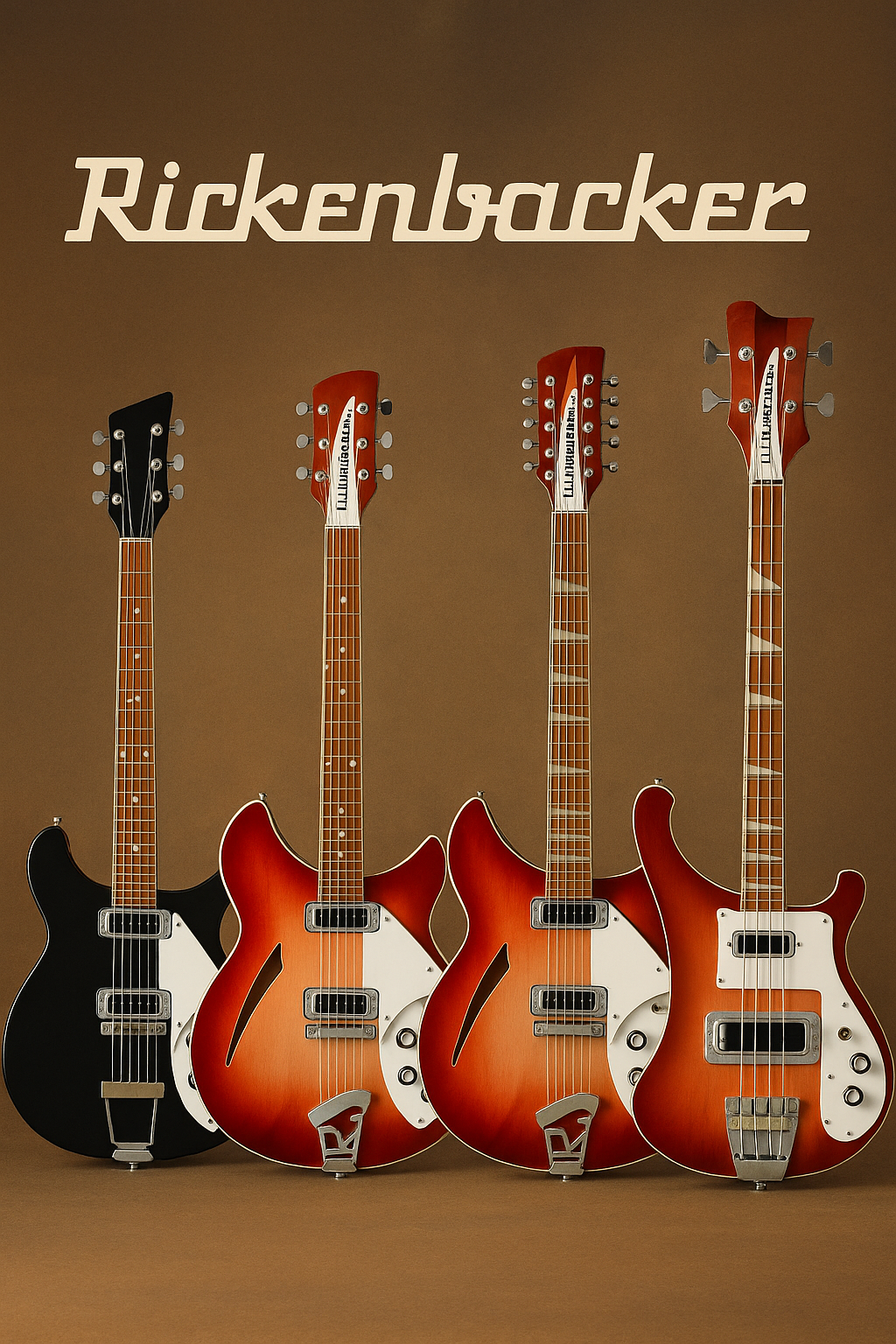The story of Rickenbacker begins in the early 1930s, at a time when electric amplification for stringed instruments was still novel and experimental. The company traces its roots to the Electro String Instrument Corporation (also known early on as “Ro‑Pat‑In”) founded by Adolph Rickenbacker and George D. Beauchamp.
The “Frying Pan” and Early Lap Steel Guitars
One of the most famous early instruments is the Rickenbacker “Frying Pan” (Electro A‑22), a cast‑aluminum lap steel that is often credited as the first commercially successful electric guitar (or at least the first electric steel guitar).
The idea was to eliminate feedback and bring volume to Hawaiian/steel guitar styles. The horseshoe magnet pickup (arching over the strings) became something of a visual and technological signature.
Over time, Rickenbacker also experimented with Electro‑Spanish models (i.e. guitars with conventional necks) like the Ken Roberts and Model B. The Ken Roberts model is sometimes called the first true “modern” electric Spanish guitar, combining tremolo (Vib-Rola) and electric pick‑ups. The Model B (1935) used a Bakelite/plastic body (not fully solid wood) to reduce feedback.
These early instruments laid groundwork, but production was small, and electric guitars were still niche.
Mid‑Century Transition: From Lap Steel to Electric Guitars and Basses
Through the 1940s and 1950s, Rickenbacker continued producing lap steels and hollow/semi‑hollow electrics. They gradually evolved toward the kinds of electric guitars and basses we now associate with their brand.
One turning point was in the 1950s, under the leadership of F.C. Hall, who pushed the brand toward modern electric guitars. The Combo 600 and Combo 800 models (in 1954) represent some of the first “modern” electrics from Rickenbacker.
Another major step was bringing in Roger Rossmeisl, a German luthier/designer, who refined the body shapes (cutaways, aesthetics) and design language of Rickenbacker electrics.
By the late 1950s, Rickenbacker had established the “300-series / Capri-series” line of guitars (short- and long-scale variations) and the beginnings of their bass line.
Iconic Models & Their Impact
300 series / Capri models (e.g. 325, 330, 360 series)
One of the most enduring voices of Rickenbacker guitars comes from the 300-series (initially the “Capri” line). These are semi-hollow guitars with distinctive body contours, sharp double-cutaway shapes, and unique electronics.
-
Rickenbacker 325: A short-scale model, famously adopted by John Lennon early in The Beatles’ career. Lennon’s 1958 325 (later modified) became iconic, and the 325c64 “Miami” variant is a tribute model.
-
Rickenbacker 330: Perhaps the best-known “jangle rock” guitar, used by many 1960s and later artists. It features two single-coil pickups, a three-ply maple/walnut neck, shallow body, and R-shaped tailpiece.
-
Notable users: Pete Townshend, Paul Weller, Peter Buck (R.E.M.), Johnny Marr, The Edge (12-string versions), among others.
-
-
Rickenbacker 360 / 375 / 370 Capris: These are longer-scale or deluxe variations, with stereo/Rick‑O‑Sound outputs and additional pickups.
-
Rickenbacker 360/12 (12-string electric): Introduced in 1963, this 12-string model had a huge influence. George Harrison famously used a Rickenbacker 12-string, and its chimey, bright “jangle” tone helped define the sound of some Beatles songs and subsequent British Invasion / folk-rock bands.
-
Also worth mentioning: The “Light Show” variant 331 (with internal lights) in the early 1970s, though it was short-lived.
These instruments allowed Rickenbacker to carve a distinct niche — their guitars were not meant to compete directly with Stratocasters or Les Pauls, but to offer a different tonal palette: bright, crisp, with presence, often with stereo capability.
Bass Instruments: The 4000, 4001, 4003 and Beyond
While Rickenbacker guitars got much attention, their basses have been equally influential. The 4000 series and its successors became staples in rock and progressive music.
-
Rickenbacker 4001: Introduced in the early 1960s, it featured a thin neck, dual-truss rod, and “horseshoe” pickups (in earlier versions). Its bright, punchy sound with strong harmonics made it stand out.
-
Rickenbacker 4003: A later model that improved on the 4001’s durability, electronics, and bridge design. Many modern Rick bassists use 4003s (or variants) for their reliability and tone.
-
Rickenbacker basses were also known for their distinctive body shapes (asymmetrical horns, offset aesthetic) and the clarity they brought to bass lines in mixes.
Famous bassists who have used Rick basses include:
-
Chris Squire (Yes) — his Rickenbacker tone became a hallmark in progressive rock mixes.
-
Geddy Lee (Rush) — used Rickenbacker basses extensively (though often modified) to carve out a lead‑bass role in power trio settings.
-
Lemmy Kilmister (Motörhead) — turned his Rick bass into a gritty, distorted engine in his own right, playing it more aggressively than many bassists.
-
Paul McCartney (The Beatles) — for some period, McCartney used a Rickenbacker 4001S bass.
-
Others: Michael Anthony (Van Halen), Andy Bell (Oasis), Frank Allen (Searchers), Geezer Butler, and many more.
Additionally, Rickenbacker basses were often modified by players (e.g. swapping pickups, bridges) to suit personal preferences.
The “Beatles Effect” and Boom in Popularity
One pivotal moment in Rickenbacker’s story was the adoption by The Beatles:
-
John Lennon used a Rickenbacker 325.
-
George Harrison famously played a Rickenbacker 12-string (e.g. 360/12).
-
Paul McCartney used a Rickenbacker bass for a time.
Their high-visibility use of Rick instruments sparked major demand globally. Before the Beatles’ explosion in popularity, Rickenbacker was still relatively boutique; afterward, the company found itself struggling to keep up with orders.
Due to that demand surge, in 1964 Rickenbacker relocated production from Los Angeles to a larger facility in Santa Ana, California.
By the mid‑1960s, waiting lists for Rickenbackers sometimes stretched months, underscoring how much the brand had been elevated by its association with major artists.
Design and Craftsmanship: What Makes a Rickenbacker Unique
A few aspects of Rickenbacker instruments distinguish them:
-
Handcrafted in the USA: Even today, Rickenbacker claims that each guitar is built by hand at their Santa Ana facility, with attention to detail in its thin, proprietary finish and individual inspection.
-
Thin finish / aesthetics: The finishes are relatively thin compared to some mass-production standards, which can make flaws more visible and demand skilled workmanship.
-
Stereo / Rick‑O‑Sound wiring: Many models (especially in the 360 line) include stereo outputs or unusual wiring to let the two pickups go to separate amplifiers for creative stereo effects.
-
Dual truss rods: Many Rickenbacker guitars (notably 300-series) have dual truss rods to control neck stability and minimize twist.
-
Signature body shapes: The crescent moon double-cutaway, sharp edges, asymmetrical horns (esp. on basses), and unique tailpieces (R-shaped) give Rick instruments a visual identity.
-
Distinct tonal character: Rick guitars are often praised for their “jangly,” chiming, clean-to-dirty transition tone, while basses emphasize harmonic clarity. These sonic traits make them particularly suited to certain genres (folk-rock, jangle pop, progressive rock, etc.).
Evolution, Challenges, and Legacy
Over the decades, Rickenbacker has faced competition from Fender, Gibson, and other brands. Many players argue that Rickies are not ideal for “shredding” lead guitar roles due to limitations in pickup output, sustain, or bridge designs, but their strengths lie elsewhere — clarity, character, chime, and presence.
Also, as music styles changed, the “jangly” get-up that Rick guitars were known for became less in vogue in hard rock, heavy metal, etc. That may have limited their adoption in some genres.
Still, Rickenbacker has maintained a steady cult and professional following. They carefully manage output (production is not massively scaled) and preserve their craftsmanship ethos.
In modern times, tribute and signature models continue to keep the heritage alive (e.g. Roger McGuinn signature, 360/12 reissues, etc.)
Closing Thoughts
From the aluminum-bodied “Frying Pan” lap steel to the electrified 12-string that helped define the sound of The Beatles, Rickenbacker’s journey is a fascinating slice of musical and technological history. Its guitars and basses remain iconic not only for their visual style but for the tonal voices they’ve contributed to generations of music.









